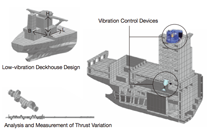Indian Seafarers Freed After Months of Detention at Yemen’s Ras Isa Port
India says it has secured the release of more than 150 seafarers who were stranded at Yemen’s Ras Isa Port, according to the Directorate General of Shipping. All 11 vessels...

As the fuel consumption efficiency of a ship is becoming a primary concern for shipowners, the length of the hull and the operating speed of the main engine decrease while the breadth increases. The height of the deckhouse is also increased to provide navigation visibility for large container carriers. Moreover, reinforced vibration regulations come into effect in accordance with shipowners ‘ demand for comfortable cabins. Such changes make the existing anti-vibration solutions ineffective and thus a new low vibration design and vibration control scheme are necessary. Hyundai Maritime Research Institute (HMRI) has developed various technologies satisfying lower vibration limit (3 mm/s) including low-vibration deckhouse design, the exact evaluation of major excitation forces, and the development of vibration control devices.
Low-vibration Deckhouse Design
Elaborate parametric study was carried out to determine the optimal shape of the deckhouse in order to reduce vibrations. Different dimensions for the deckhouse were used according to various main engines. In addition, the wall lay-ups and supporting structures
were modified to control the rigidity of the deckhouse. Such design changes were applied to entire vessels such as VLCC, VLOC, VLOO, bulk carrier and containerships. It was found that the vibration level decreased drastically compared to that of the existing deckhouse design.
Evaluation of Major Excitation Force
Among various ship-borne excitation forces, thrust variation due to main engine explosion forces were analyzed and identified theoretically and experimentally. Three-dimensional FE analysis technology of the crank and propulsion shaft system was developed to
accurately predict excitation forces due to thrust variation. Then, the excitation forces were measured through semiconductive strain gauges during the sea trial. The measured results were as predicted. From the analytical model, design guide for a propulsion shaft
was also proposed to minimize thrust variation.
Vibration excitation forces are transmitted from the main engine and the propeller to the deckhouse through the hull structure. The transmission was identified analytically by using vibration intensity analysis technique which can accurately show the transmission paths of the vibration energy in the hull structure. As the transmission and dissipation paths of vibration energy were identified, effective low vibration design was obtained.
Development of Vibration Control Device
The vibration compensator to generate active control force was developed to reduce the vibration of the deckhouse and main engine. The developed compensator was designed to adjust control force minutely. The optimal vibration control scheme which realizes the total
automatic control without any operator was built and applied to commercial vessels in order to validate its effectiveness.
The top bracing with high damping capacity is being developed as a vibration control device for the deckhouse and main engine. The stiffness and damping of the commercial top bracings were identified experimentally for the performance evaluation of the current top bracings. Design parameter sensitivities were analyzed through the simulation of hydraulic components and various experiments
were carried out for the validation of the simulation. As a result, the damping performance of the top bracing was improved.
From the study conducted by HMRI, low-vibration design and countermeasures for newly developed ships were constructed systematically. Owing to this study, HHI has acquired core technologies to guarantee the vibration level of ship’s deckhouse below the lower vibration limit of 3 mm/s.

Sign up for gCaptain’s newsletter and never miss an update

Subscribe to gCaptain Daily and stay informed with the latest global maritime and offshore news


Stay informed with the latest maritime and offshore news, delivered daily straight to your inbox
Essential news coupled with the finest maritime content sourced from across the globe.
Sign Up